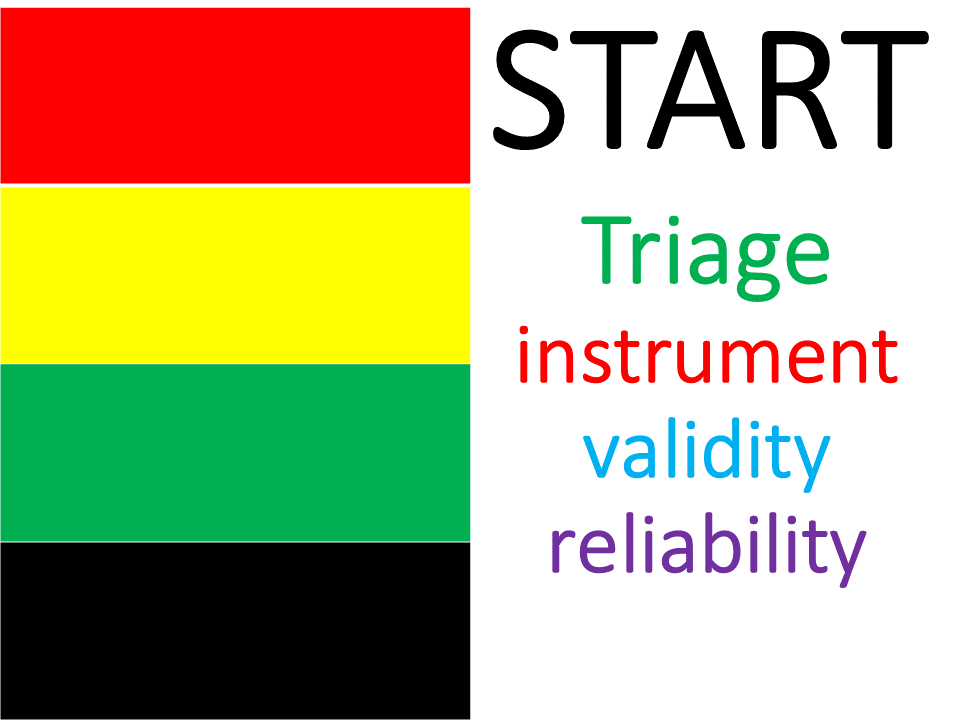A Validity and Reliability of The START Triage Knowledge and Attitude Instrument in Medical Personnel and Health Workers
DOI:
https://doi.org/10.23917/bik.v17i2.5147Keywords:
validity, reliability, instruments, knowledge, attitude, Simple Triage and Rapid TreatmentAbstract
Medical and health personnel have the potential to play an important role in triage START in the event of a disaster. However, it is important to have an instrument in evaluating the level of knowledge and attitudes of medical and health dragons regarding the START triage. This instrument is essential for the development of a comprehensive and efficient START triage education program for medical and health personnel. Therefore, this study aims to assess the accuracy and consistency of knowledge and attitude instruments in conducting START triage for medical and health personnel. A cross-sectional study involving 100 respondents. This instrument is created through a literature review. The instrument totaled 10 items of statements on knowledge and 10 items of statements on attitudes categorized into 6 groups: 1) disasters; 2) START triage; 3) START triage principle; 4) START triage indicator; 5) START triage implementation procedure. The results of this study showed 100 participants, the majority of whom were female with an average age of 36 years. All participants are medical and health personnel. The instruments used in the study were validated through content validity (Pearson Product Moment) and biserial correlation. Utilizing internal consistency reliability, the study found satisfactory inter-item reliability for all knowledge items (0.70 – 0.73) and attitude items (0.86 – 0.90). Conclusion: these findings suggest that knowledge and attitudes in performing the START triage are important for medical and health personnel
Downloads
References
Alkalash. S. H.. Alhashmi Alamer. E. H.. Allihyani. A. M.. Alhazmi. A. S.. Alharthi. R. M.. & Bugis. A. M. (2023). Knowledge of and Attitude Toward Disaster Preparedness Among Secondary School Students in the Western Region of Saudi Arabia. Cureus. 15(1). 1–13. https://doi.org/10.7759/cureus.33926 DOI: https://doi.org/10.7759/cureus.33926
Astuti. Z.. Milkhatun. M.. & Latipah. A. J. (2022). Web-Based Triage Game Application Development as A Disaster Triage Learning Tools During The Covid-19 Pandemic for Nursing Students. Indonesian Nursing Journal of Education and Clinic (Injec). 7(1). 53. https://doi.org/10.24990/injec.v7i1.452 DOI: https://doi.org/10.24990/injec.v7i1.452
Bahlibi. T. T.. Tesfamariam. E. H.. Andemeskel. Y. M.. & Weldegiorgis. G. G. (2022). Effect Of Triage Training On The Knowledge Application And Practice Improvement Among The Practicing Nurses Of The Emergency Departments Of The National Referral Hospitals. 2018; A Pre-Post Study In Asmara. Eritrea. Bmc Emergency Medicine. 22(1). https://doi.org/10.1186/S12873-022-00755-W DOI: https://doi.org/10.1186/s12873-022-00755-w
Bandura, A. (2019). Applying Theory for Human Betterment. Perspectives on Psychological Science, 14(1), 12–15. https://doi.org/10.1177/1745691618815165 DOI: https://doi.org/10.1177/1745691618815165
Bhattacharya. S.. Singh. A.. Semwal. J.. Marzo. R. .. Sharma. N.. Goyal. M.. & Srivastava. A. (2020). Impact of a training program on disaster preparedness among paramedic students of a tertiary care hospital of North India: A single‑group. before–after intervention study. Journal of Education and Health Promotion. 9(5). https://doi.org/10.4103/ jehp.jehp DOI: https://doi.org/10.4103/jehp.jehp_423_19
Bijani. M.. & Khaleghi. A. A. (2019). Challenges And Barriers Affecting The Quality Of Triage In Emergency Departments: A Qualitative Study. Galen Medical Journal. 8(4). 15-18. https://doi.org/10.31661/Gmj.V8i0.1619 DOI: https://doi.org/10.31661/gmj.v8i0.1619
BNPB. (2022). Rangkuman bencana tahun 2022.https://gis.bnpb.go.id/ arcgis/apps/sites/#/public/ pages/bencana-besar-tahun-2022
Carr. J.. & Jensen. J. (2015). Explaining the pre-disaster integration of Community Emergency Response Teams (CERTs). Natural Hazards. 77(3). 1551–1571. https://doi.org/10.1007/s11069-015-1664-3 DOI: https://doi.org/10.1007/s11069-015-1664-3
Connor. E. O.. Gatien. M.. Weir. C.. & Calder. L. (2014). Evaluating The Effect Of Emergency Department Crowding On Triage Destination. International Journal Of Emergency Medicine. 7(16). 1–7. https://doi.org/10.1186/1865-1380-7-16 DOI: https://doi.org/10.1186/1865-1380-7-16
Kamaluddin, R., Trisnantoro, L., & Alim, S. (2019). Validity and Reliability of the Disaster Preparedness Knowledge Instrument for Health Cadres in Volcanic Disaster-Prone Areas. Bali Medical Journal, 8(3), 871–877. https://doi.org/10.15562/bmj.v8i3.1543 DOI: https://doi.org/10.15562/bmj.v8i3.1543
Kurniawan. Y. R.. & Wasino. (2021). Merapi Eruption and Settlement Change in Pakem Sub-district. Turi. And Cangkringan Sleman Regency in 1990-2010. Journal of Indonesian History. 10(1). 38-47. http://journal.unnes.ac.id/sju/index.php/jih
Lampi. M.. Junker. J. P. E.. Tabu. J. S.. Berggren. P.. Jonson. C. O.. & Wladis. A. (2018). Potential Benefits Of Triage For The Trauma Patient In A Kenyan Emergency Department. Bmc Emergency Medicine. 18(1). 1–7. https://doi.org/10.1186/S12873-018-0200-7 DOI: https://doi.org/10.1186/s12873-018-0200-7
Laksono, B. B. (2024). Triage as an instrument for handling victims in disaster settings: Review Article. Nursing Information Journal, 3(2), 69-78. https://doi.org/https://doi.org/ 10.54832/nij.v3i2.689 DOI: https://doi.org/10.54832/nij.v3i2.689
Lumbu. R. S.. Niswar. M.. & Baharuddin. M. (2013). Management Information System For Coping With Disaster Victim. Repository UNHAS. 13. http://repository.unhas.ac.id/id/eprint/10865/4/ robystevil-2728-1-13-roby-%291-2.pdf
McCambridge. J.. Witton. J.. & Elbourne. D. R. (2014). Systematic review of the Hawthorne effect: New concepts are needed to study research participation effects. Journal of Clinical Epidemiology. 67(3). 267–277. https://doi.org/10.1016/ j.jclinepi.2013.08.015 DOI: https://doi.org/10.1016/j.jclinepi.2013.08.015
Melnikov. S.. Itzhaki. M.. & Kagan. I. (2014). Israeli Nurses’ intention to report for work in an emergency or disaster. Journal of Nursing Scholarship. 46(2). 134–142. https://doi.org/10.1111/jnu.12056 DOI: https://doi.org/10.1111/jnu.12056
Mirzaei. S.. Eftekhari. A.. Sadeghian. M. Reza. Kazemi. S.. & Nadjarzadeh. A. (2019). The Effect Of Disaster Management Training Program On Knowledge. Attitude. And Practice Of Hospital Staffs In Natural Disasters. Journal Of Disaster And Emergency Research. March. https://doi.org/10.18502/Jder.V2i1.566 DOI: https://doi.org/10.18502/jder.v2i1.566
OHCA. (2022). Global Natural Disaster Assessment Report. UN Annual Report. October. 1–80. https://reliefweb.int/report/world/2021-global-natural-disaster-assessment-report
Taryudi. T. (2021). Establishment of First Responder (FR) Based on the Internet of Things as an Effort to Increase the Capacity of Health Workers for Disaster Emergencies in the Tangerang Puskesmas Working Area. Banten. Abdimas BSI Journal: Journal of Community Service. 4(2). 174-180. https://doi.org/10.31294/ jabdimas.v4i2.9188 DOI: https://doi.org/10.31294/jabdimas.v4i2.9188
Veenema. G. (2018). Disaster Nursing And Emergency Preparedness (4th Ed.). https://doi.org/10.1891/9780826144225.0022 DOI: https://doi.org/10.1891/9780826144225.0022
Wang. Z. Y.. Zhang. L. J.. Liu. Y. H.. Jiang. W. X.. Jia. J. Y.. Tang. S. L.. & Liu. X. Y. (2021). The effectiveness of E-learning in continuing medical education for health workers: a quasi-experiment from China. Infectious Diseases of Poverty. 10(1). 1–11. https://doi.org/10.1186/s40249-021-00855-y DOI: https://doi.org/10.1186/s40249-021-00855-y
Widayatun. & Fatoni. Z. (2013). The Role Of Health Personnels And Community Participation Health Problems In A Disaster Situation: The Role Of Health Personnels And Community Participation. Indonesian Journal of Population. 8(1). 8-10. https://doi.org/ 1907-2902

Downloads
Submitted
Accepted
Published
How to Cite
Issue
Section
License
Copyright (c) 2024 Novia Faizatiwahida, Julfilkar Adnan Irnu, Pusparini Anggita Ayuningtyas, Haslindar Hatta, Intansari Nurjannah, Syahirul Alim

This work is licensed under a Creative Commons Attribution 4.0 International License.


















